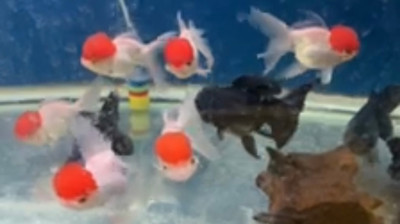Red Cap Oranda
Posted by Max Gandara on on 8th Jun 2025
Red Cap Oranda: The Crown Jewel of Fancy Goldfish
The Red Cap Oranda is a living work of art. With its striking snow-white body and vibrant cherry-red "cap" on its head, this fancy goldfish turns any aquarium into a regal display. Elegant, slow-moving, and full of personality, the Red Cap Oranda is a favorite among aquarists who admire both beauty and tranquility in their fish tanks.
Though not the easiest goldfish to care for, they reward patient keepers with graceful swimming and long lives when kept in the right environment.
Species Overview
-
Scientific Name: Carassius auratus (Fancy Goldfish variety)
-
Common Name: Red Cap Oranda
-
Origin: Selectively bred in China and Japan
-
Size: 6–8 inches (15–20 cm), up to 12 inches in large tanks or ponds
-
Lifespan: 10–15 years (can exceed 20 with excellent care)
-
Temperament: Peaceful, gentle
-
Tank Level: All levels, mostly mid and bottom
What Makes Red Cap Orandas Special?
The Red Cap Oranda is distinguished by its:
-
Wen – A fleshy, raspberry-like growth on its head, which becomes prominent as the fish matures
-
Color Pattern – A snow-white body with a vivid red "cap" on the head, giving it a traditional and ornamental look
-
Body Shape – Rounded, egg-shaped body and flowing fins that make them graceful but slow swimmers
These unique traits make the Red Cap Oranda not only beautiful but also symbolic of good fortune and longevity in Asian cultures.
Ideal Aquarium Setup
Despite being goldfish, Red Cap Orandas are not beginner-proof bowl fish. They require a well-maintained tank with proper filtration and space.
Tank Size:
-
Minimum: 20 gallons for one, plus 10–15 gallons for each additional Oranda
-
Ideal: 40–75 gallons for a pair or small group
Water Parameters:
-
Temperature: 65–75°F (18–24°C)
-
pH: 6.5–7.5
-
Hardness: 5–20 dGH
-
Filtration: Strong biological and mechanical filtration; low to moderate current
-
Aeration: Essential — goldfish are oxygen-demanding
? Tip: Use sponge filters or pre-filters to avoid damage to delicate fins and reduce the risk of wen injuries.
Substrate & Decor:
-
Soft sand or smooth gravel (to prevent injury while foraging)
-
Live or silk plants (avoid sharp plastic décor)
-
Plenty of swimming space — keep decorations minimal and safe
Tankmates: Choose Wisely
Red Cap Orandas are slow, peaceful fish that should be housed with similarly tempered species.
Ideal Tankmates:
-
Other fancy goldfish (Ranchu, Ryukin, Telescope)
-
Peaceful bottom-dwellers like dojo loaches or bristlenose plecos (watch size)
-
Avoid:
-
Fast, competitive fish (e.g., Comet goldfish, Koi)
-
Fin-nippers (e.g., barbs, tetras)
-
Tropical species requiring higher temps
-
Feeding: Diet for Growth and Color
Red Cap Orandas are omnivores with big appetites, but their round bodies make them prone to swim bladder issues if overfed or fed improperly.
What to Feed:
-
Staple: High-quality sinking pellets or gel foods (Repashy, Hikari, Fluval Bug Bites)
-
Fresh/Frozen Foods: Bloodworms, brine shrimp, daphnia (as treats)
-
Vegetables: Blanched spinach, peas (de-shelled), zucchini
Feed 2–3 small meals per day, and remove uneaten food to maintain water quality.
⚠️ Avoid floating flakes — they can cause air ingestion and buoyancy problems.
Special Care for the Wen
The "cap" or wen is a unique feature, but it requires some attention.
Tips:
-
Keep water pristine to avoid bacterial/fungal infections
-
Avoid sharp or rough decor that can damage the head
-
Monitor for overgrowth — in rare cases, surgical trimming may be needed (by a vet)
-
Look out for signs of fungus or injury
Common Health Issues
Red Cap Orandas are more delicate than common goldfish, especially due to their body shape and wen.
Watch Out For:
-
Swim bladder disease (floating or sinking)
-
Wen infections (white patches or slime)
-
Ich or fin rot (stress-related or due to poor water)
-
Ammonia poisoning (from overfeeding or inadequate filtration)
? Prevent with:
-
Weekly water changes (30–40%)
-
Regular water testing
-
A varied, quality diet
Breeding Red Cap Orandas
Breeding is possible in home aquariums, though best done in large tanks or ponds.
Breeding Facts:
-
Males develop white breeding tubercles on gill plates
-
Spawning often occurs in spring with temp increases
-
Provide spawning mops or fine-leaved plants
-
Eggs hatch in 3–5 days
-
Parents should be removed post-spawning to prevent egg predation
Fry require infusoria or commercial fry food until they grow large enough for baby brine shrimp.
Final Thoughts
The Red Cap Oranda is a timeless fancy goldfish with unmatched elegance and peaceful personality. It thrives in spacious, well-maintained aquariums with low-stress environments and plenty of love. Though it requires a bit more care than simpler fish, the reward is a stunning, personable aquatic companion that can live for over a decade.
Whether you’re building a traditional goldfish setup or an ornate aquascape with slow, graceful fish, the Red Cap Oranda adds both beauty and serenity to your tank.

